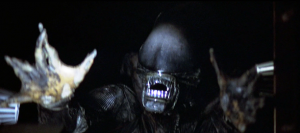
FOUR movies strong, and spanning three decades (the 1970s, 1980s, and 1990s), the cinematic Alien saga — consisting of Alien (1979), Aliens (1986), Alien 3 (1992) and Alien Resurrection (1997) — is renowned for its titular creature, one of the most terrifying silver screen boogeymen of all time.
Given the nature of this franchise’s hostile (and perfect?) monster, it’s no surprise that the death scenes featured throughout the saga are frequently terrifying, bloody, and brilliantly-orchestrated.
Yet the truly memorable death scenes possess another quality as well. They’re shocking. These scenes strike with a combination of terror, disgust, sorrow, and surprise, leaving a permanent imprint on the viewer’s mind.
For a death scene to be considered shocking, it must be one that the audience can’t see coming. In other words, we expect that Colonial Marines fighting aliens by the pack are going to die, or that confused convicts running from a monster in a dark corridor will come to a bad end.
Similarly, a really shocking death scene must involve a character that we have come to care about. A death scene can’t shock us if we’re not engaged in what is happening on screen, or empathizing with the imperiled people.
Finally, the nature of the death — how gruesome it is, essentially — also plays a key role. To see someone you have invested time in suddenly taken out before your very eyes, often bloodily, can be quite bracing.
With this definition in mind, the following five death scenes represent not necessarily the best moments of the Alien saga, but simply the most shocking of the movie series’ death scenes, of which there are over two-dozen.
You may notice that the lion’s share of the shocking deaths, in my estimation, come from installments 1 and 3.
That’s in no way because Aliens (1986), the second installment, is a bad film. On the contrary, it is because the James Cameron film goes to tremendous lengths to create memorable characters and character relationships, and many of those beloved characters expire horrifically…but in Alien 3(1992).
In other words, Aliens brilliantly sets up the shocks of its own sequel, which then benefits from all that hard work.
Similarly, Alien Resurrection is not represented at all in the following list below because by the time of that relatively-tired entry in the franchise, a sense of familiarity had set in like a hardening of the arteries, and though the deaths in the film may be effective at times, none are particularly surprising or unexpected, let alone “shocking” in the sense that the following five are. In fact, some deaths in the fourth film, such as General Perez’s (Dan Hedaya), are even played for cartoon laughs.
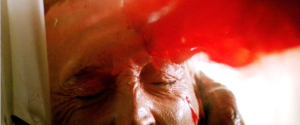
5. A Lover’s Death: Dr. Clemens (Alien 3)
Ellen Ripley (Sigourney Weaver) has already endured and survived much pain and death by the first act of this widely-disliked David Fincher film. She finds herself without friends, marooned on a planetary penal colony of rapists, thugs and murderers. Unexpectedly, Ripley makes a friend with Dr. Clemens (Charles Dance), a decent man with a tragic history.
Surprising just about every Alien fan, Ripley decides to sleep with Clemens. She then plans to tell him the truth about her history, but not before he shares his own sad tale, and how he came — through a horrible mistake — to become a prisoner on Fury 161.
But before their relationship can develop further along the honest, if world-weary lines established, the alien appears in the prison infirmary and promptly pulps Clemen’s skull. This murder thus removes Ripley’s only ally, and the only person on Fury 161 who might possibly believe her story of an alien monster on the loose.
The whole Clemens subplot is predicated on surprise and shock. It is a surprise that Ripley reaches out to Clemens. It is a surprise that he’s actually a prisoner at the facility, and then it is a (bloody) shock that he is dispatched almost instantly after we get to like him. David Fincher has often lived by the aesthetic that “movies should scar,” and Clemens’ role here seems to conform to that notion.

4. A Friend’s Death: Bishop (Alien3)
Bishop (Lance Henriksen) barely survived the events of Aliens. A great and shocking scene in the Cameron film’s finale showcased the alien queen shearing him in two.
But Bishop didn’t die in that scene. Instead, he survived to the sequel. In the third Alien film, Ripley finds the android’s torso in a garbage pile and attempts to understand why she and the others were ejected in cryo-stasis from the Sulaco in mid-flight.
After helping Ripley acquire that data, Bishop proves his innate humanity by taking the surprising step of requesting de-activation. In other words, he wants to die. Essentially, he asks Ripley — his friend — to assist him in committing suicide.
This is such a shock because Bishop is one of Ripley’s most steadfast friends, and her only support here on this planet, at this point. But instead of offering to help her come up with a way to fight the alien, he seeks only the peace of oblivion.
Bishop goes out with a whimper instead of a bang, as Ripley removes the power rods keeping him alive, and he just slips away peacefully.
This scene represents a unique inversion of the human/android dynamic of Aliens. In this case, the human serves the android’s needs, not vice-versa, and Ripley says goodbye to a friend, and a beloved character in the franchise. By this point in the film, we had already lost Hicks and Newt, and the loss of Bishop is the final, shocking straw. As late as this scene, it seemed possible that, as an “artificial person” there was hope for Bishop’s restoration.
This shocking death scene proves otherwise. The ad-hoc “nuclear family of Aliens is now gone.
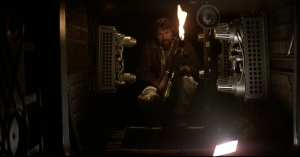
3. The (False) Hero’s Death: Captain Dallas (Alien)
One of the key reasons why the original Alien (1979) was so successful as a horror film and a work of art involved the film’s sense of utter unpredictability, not merely in the ever-changing appearance of the creature, but in the crew dynamics.
A generation of viewers had been conditioned by programming like Star Trek (1966 – 1969) to look to the Nostromo’s alpha male, Captain Dallas (Tom Skerritt) as the film’s savior and hero. The film’s screenplay keys in on this expectation, and Dallas bravely goes into a vent-shaft to flush the alien out of the ship in flight.
Because he is our hero — the ship’s captain — we expect him to succeed.
But he doesn’t.
Instead, Dallas takes a wrong turn in the dank underworld of that old, dark spaceship, and runs smack into a full-grown alien…which lunges murderously at him.
With Dallas gone, our hopes turn to the most competent crew member, Ripley, and a new action hero rises.
But in 1979, no one could have expected that the captain of the Nostromo, the anticipated hero of the film, would meet his demise before the third act. This shocking death is not gory, but it is surprising, and one hell of a jump scare.
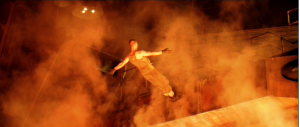
2. Heroic Sacrifice: Ripley’s Death (Alien 3)
Many Alien fans did not care for the third Alien film. The production was troubled. And one can easily make the case that the film was too dark, and that it featured too many shocking deaths. We saw the death of Newt and Hicks off-screen, and then the aforementioned death of Bishop.
But the overall idea of the film was — and remains — a noble one. It was, simply, The Last Temptation of Ripley. With all her friends gone, with her adopted child dead, Ripley had to continue to fight. And she had to do so so among people she didn’t really care about.
More to the point, when Ripley learned that she had been impregnated with an alien queen embryo, she had to decide if she should attempt to survive for a new life — one with family and children — or die to save the universe from the alien plague.
Her hair shorn like Maria Falconetti’s in The Passion of Joan of Arc (1928), Ripley made the latter choice, and — in an unforgettable crucifixion pose — went to her death a hero.
There was no last minute reprieve, now narrative trickery, and the film by David Ficnher ended with a visual montage of doors closing, indicating that this was really and truly the end; that all doors on the Alien franchise had been sealed tightly shut.
Alien Resurrection over-wrote that definitive sense of closure, and gave us a new Ripley-alien hybrid clone, but the message of 1992’s film installment was that there are some things in life more important than survival.
Ripley sacrificed herself for those things…for the rest of us. The scene is shocking because, right up until the moment when she plunges, we aren’t sure if some miracle is going to occur, and if she is going to find a way out of her plight that also continues her life.
In the end, that hope is dashed, and Ripley burns up in a furnace, on a back-water planet, surrounded by strangers.
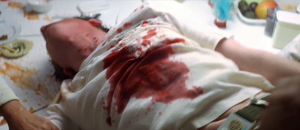
1. The Surprise Death to End Them All: Kane’s Death (Alien)
The first death in the Alien saga remains the franchise’s most shocking one.
This is due in part to the scene’s placement in history as the first (known) death caused by the xenomorph, and also by the fact of its brutal, disgusting, unexpected nature.
Here, the crew of Nostromo eats a last meal together before going back into the freezers for the long journey home to Earth. Suddenly Kane (John Hurt) — who has apparently recovered from his experience with the crab-like face-hugger — begins to convulse.
The other crew-members rush to his aid, and at first it seems like he is merely choking, or having a strange seizure.
But then a splotch of red blood discolors his shirt, the sound of ripping tissue and flesh is heard on the soundtrack, and the chest-buster blows out of Kane’s innards in a fountain of crimson blood.
The blood splatters the other, shocked crew members, the chest-burster squeals plaintively…and then runs into darkness, and the audience is left in abject shock and horror at what it has witnessed.
Such is the power of this scene that it has not been improved upon, or outdone in three successive films, or numerous spin-offs.
Alien’s shock of the new still resonate.
Would you like to support Flashbak?
Please consider making a donation to our site. We don't want to rely on ads to bring you the best of visual culture. You can also support us by signing up to our Mailing List. And you can also follow us on Facebook, Instagram and Twitter. For great art and culture delivered to your door, visit our shop.








